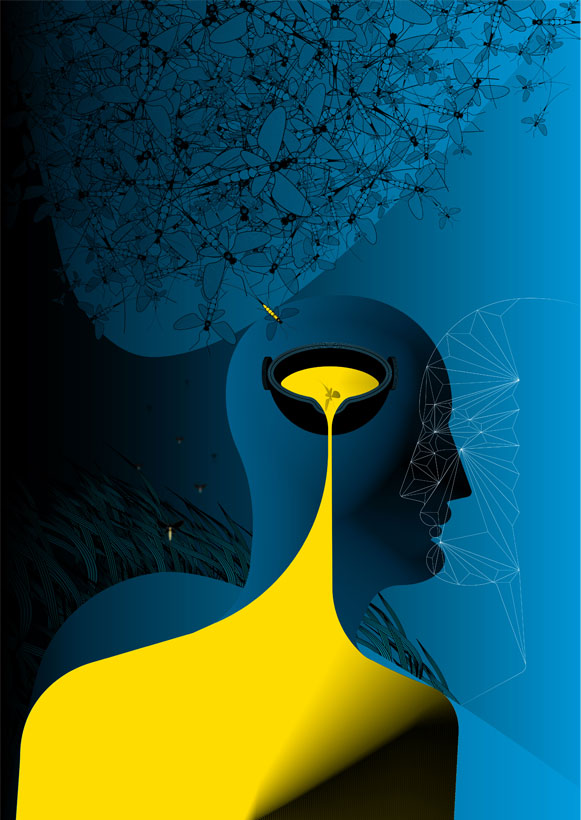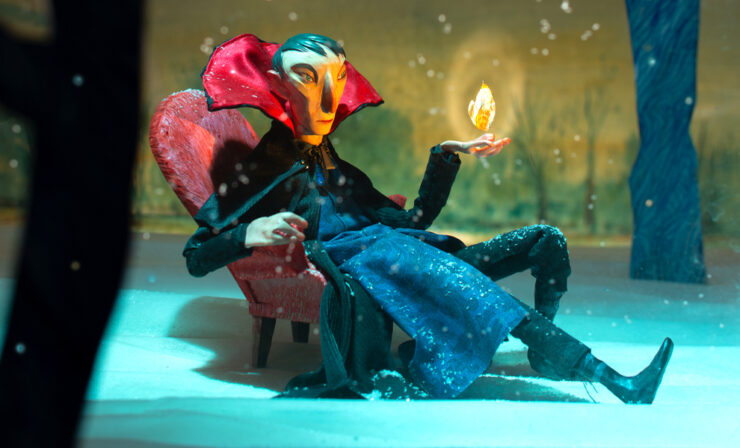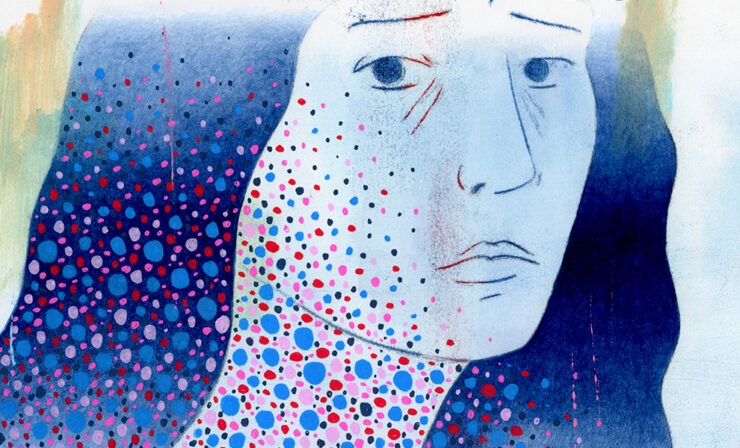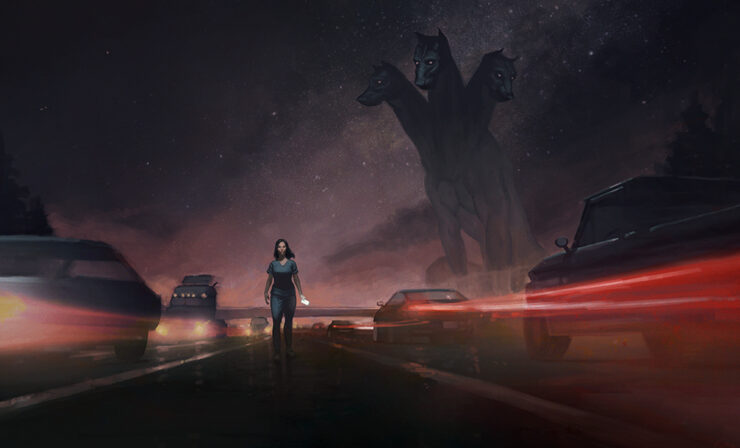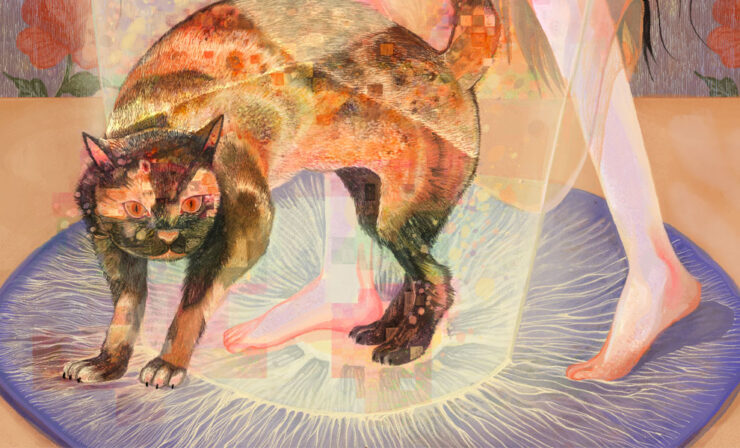Metallurgists are both admired and feared. They splinter their own minds in order to manipulate metal at the microscopic level, creating shadow selves to craft the nano-architecture of metal alloys into perfection. Near the vast steelworks of Karshad, a journalist has fallen in love with the residual personality of a metallurgist, but what will happen when realliance—and forgetting—comes?
Translated by Julie Novakova.
I have always thought that we were something more. I believed it.
But now, as we walk through fields of strongly deformed grains stretched like smudges of veil-like clouds on the morning skies, as we navigate cautiously between their boundaries blurred by slips along pyramidal planes, as Bainite needles rise from our bodies just to dissolve with a deafening roar of acoustic emission, now…I’m starting to have doubts.
In Karshad, everything was somehow strange, unseemly: the ceramic foam heat barriers resembling medieval city walls, hearths of the forges and blast furnaces glowing into the dark like blood-red headlights turned to the skies shrouded in smog. And Bamobah standing beside me in her silvery jumpsuit. Still beautiful, yes, but beautiful in her distant, desert way, so contrasting with the immediate reality of the filth and cough of the steelworks. The barriers surrounding us were overwritten with Middle-Eastern scripts I had never seen before. But seeing the symbol of three forebodingly intertwined dislocation lines above each of them, I knew what they meant. Sahabai metalurgim: The Cloud of Metallurgists.
“Don’t stare, just come.” Bamobah reached her hand out to me, but stopped an inch from mine. “That doesn’t concern us.”
“I know.”
The path was trodden in dust and slag. Somewhere the outlines of stairs, worn smooth, could be glimpsed. Everything was wrong. Settling in Bamobah’s wavy black hair should not be ash, but sand. Reflecting from her dark-brown eyes should not be the glow of searing metal, but beams of the sun setting over a desert.
I shook my head and walked on. We were in Karshad already for four days, but the places we had seen blurred into one in my mind. Waiting rooms, walkways, elevators, off-white floors dirty with dust and ash from the soles of our boots. I waited, while Bamobah lay down on the diagnostic tables, waited, while she was answering psychoanalysts’ questions. And when my waiting was finally over, when she emerged from the padded door in late evening, even paler than before, she only gave me an empty, indecipherable gaze.
“How is it? Everything all right?” I asked.
She nodded briefly. “Yes, of course.”
┴ ┴ ┴
When we lived in Piraka, in a tiny flat rented by my editorial office for me, we slept in my uncomfortable creaking bed. Beneath one blanket, in a pleasant contortion of limbs.
Here in Karshad, the steelworks provided a luxury hotel room for us. A room with two single beds. We were filling in heaps of forms Bamobah had brought from her medical examination, in silence. Then we just wished each other good night and switched off the light. The charm of the desert was lost in the silent hum of air conditioning.
Far west, where the sea of sand met the real sea, Piraka was also fast asleep. I imagined its congress center, all soundless in the middle of the night. I had met Bamobah there. I recalled her sitting on a soft chair and absently listening to someone’s speech. Her gaze traveled to me for a moment.
“Before I give you my answer,” she said when I finally dared to talk to her and invite her to dinner, “you must know something about me.”
I was prepared for everything, apart from what she said next: “I’m a metallurgist. I mean right now.”
Bamobah would have understood if I told her a polite goodbye at that moment. If I stopped looking into her eyes and disappeared at the first opportunity.
But instead, I imagined her walking, tall and proud, through the heart of a sizzling ingot, caressing the ribbons of Laves phase with her slender fingers, and her wavy hair overflowing with loops of Frank-Read sources. And I found it enchanting. Alluring. Stirring.
“Which steelworks?”
“Karshad. I’m coming back in six months.”
“Six months is a long enough time,” I said and walked with her to the car.
┴ ┴ ┴
The Bamobah I had come to know had a simple, modest lifestyle. That, of course, didn’t say anything about her real income, only the allowance she was receiving during each shift. Before she moved in with me, she had lived in an unobtrusive, but certainly not cheap hotel.
Once, when we were leaving the town for the weekend and passed by the small islands of luxury residential quarters scattered over the hills by the northern edge of Piraka, Bamobah pointed down to the shore. “There’s my house.”
I looked and saw the white shining roof of a large villa surrounded by a tall hedgerow. “What is it like there?”
She shrugged. “I don’t know. Spacious. Modern. I like it and feel good there, I suppose.”
It was fascinating and confusing how Bamobah could speak about both of her personalities in first person in one sentence: her primary consciousness working in the ingot’s microstructure, and the residual consciousness remaining in her human body.
To understand it, I had to first fully understand who’s sitting beside me. Her face, her eyes, her voice, her smile – all of that was just an empty shell and its mind merely a residuum, an imprint left in her brain by the primary when it had left for the ingot. So when Bamobah talked about the being that had left, she couldn’t have used another word than “I”.
For a second, I contemplated leaving the highway and taking a small detour to see the house up close, but I knew that Bamobah would refuse. Most metallurgists behaved just as she did: considered their residuals as strangers and kept them as far away as possible from their fortune, privacy, and friends. It was the simplest and most reliable way to avoid trouble surrounding the return, the realliance shock and the psychological paradox of coinciding memories.
When we lay on a beach later that evening under the starry sky and listened to the waves and the eerie song of the desert wind, Bamobah said into the darkness: “We’ll take a different route back.”
“Is it the house? You don’t want to see it?”
“I don’t want you to see it. Not now. Perhaps when I come back.”
Something clenched inside me and the stars became millions of eyes staring at me from the dark heights. Bamobah was rolling grains of sand on my belly pensively.
“You have no idea how bad I wish…when this is over…when I come back…for us to…” she was struggling for words, but there were none for what she was attempting to say.
“For us to still be friends?” I suggested.
“For us to still be friends,” she echoed.
Friends? I had always thought we could be something more. I believed it.
We took a different route to the town the following day.
┴ ┴ ┴
Another evening, a month or two earlier, I was returning the same way from an errand in the north. It was still cold and got dark early. With the coming night, cold swept over Piraka and lifted a veil of salty mist from the sea. Dusk sucked all colors and sounds from the town; I remember cars noiselessly creeping through the roads like night predators sweeping their territory with cold halogen lights. The red glow of their back lights stung my eyes. In my imagination, they became narrow slits through which you could glimpse the red-hot metal beings living inside.
I was hurrying to Bamobah, tired and looking forward to seeing her. I turned off the autopilot to drive faster. With every car I passed, my heart skipped a beat. I prolonged each green light in the way I needed. I thought I was a good driver. I knew the way by heart. And then my world was eclipsed by the side of a truck that emerged from another street, and I couldn’t stop despite slamming the brakes down, despite the scream coming from my mouth.
I had to close my eyes.
I won’t ever forget what I saw when I opened them again. The first foam blisters bloomed in the car’s hood around the site of impact. More and more were stemming from it like a slow-motion avalanche, like bubbles in boiling water. The structural memory of the metal woke up, disturbed from many years’ sleep by the energy of the impact. Hundreds of millions of high-angle grain boundaries oriented so that adjacent grains could slide the right way at the right time. Hundreds of millions of gas molecules trapped in interstitial places and Schottky’s grid defects, prepared to desorb into the budding pores. Hundreds of millions of antiphase boundaries of intermetallic ordering, capable of instant annihilation and pumping kilojoules and kilojoules of structural entropy into the material. Hundreds of millions of dislocations prepared to run along slip planes. Each microsecond a billion microstructural events so complex that I could barely imagine them. If I had driven a car whose deformation zones weren’t made of material modified by an in-situ metallurgist, I would have most likely been dead. Someone had spent weeks and weeks in the ingot to prepare the complex nanoarchitecture of defects and gradients. By lending its primary personality to the searing metal, someone had saved my life today. Someone like her.
I felt a strange relief, as if Bamobah was beside me suddenly, as if she embraced and stroked me. Instead, safety belts shifting their structure similarly to the car’s hood were holding me. When I unfastened the belts, and stumbled outside, dazed with adrenaline, I was smiling and tears streamed from my eyes. My hands shook when I was dialing the police and then the insurance company, but I didn’t stop smiling into the mist.
The real Bamobah did not embrace me when I finally got home two or three hours later. She sat with her knees pulled to her chin, staring at the phone before her. Only then I realized with horror that I hadn’t let her know. I started apologizing and explaining what had happened. Bamobah listened in silence, reserved and graceful like only she could master, and then said: “I was afraid I’d lose you.”
Perhaps at that moment, I realized how much I’d feared losing her.
┴ ┴ ┴
Some alloys can kill. Death may lurk inside the Guinier-Preston zones, and if not death, then at least transformation precluding return. Metallurgists know of these places and avoid them, surround them with walls of precipitates, concentration gradients and nanostructured boundaries. But, in a strange dual logic, even the most cautious ways through the ingot often lead them alluringly close to these places. There is a thin line between fear and temptation.
This is what the residual personalities fear most: that their primaries would willingly give up the option to become a human being again and decide to stay in the ingot until quenching. That they would cut their humanity off like when a tow plane cuts off a glider high in the clouds and leaves it to the whims of the wind. A metallurgist is a microstructural entity, it’s not human or animal, its consciousness isn’t necessarily bound to its physical integrity. It may still be present in the alloy when diamond saws bite hungrily into the ingot, it may live and sense under the fiery touch of milling cutters, in the racket of rolling mills, under the pounding of power forging hammers, within the crushing embrace of molds.
There are hints, and there is belief. There is a cult. There are residuals unable to make peace with their primaries’ death. They feel their presence in all the places where pieces of metallurgists from the ingots could have gotten. In turbine blades of aircraft engines, in micromanipulators, in biomechanical implants, in active rivets of architectural structures, in surgical instruments, in antennas of geostationary satellites.
They feel themselves to be a part of the…
Cloud.
┴ ┴ ┴
“I don’t like truth,” Faíd told me when we met face to face for the first and last time. “It reminds me of a spoiled brat from a ‘good’ family who doesn’t have to be smart, original or pleasant, but everyone feels he should come before others. If you’re convinced something is right, should you toss it away just because the truth is different?”
We sat in the Al Emerald hotel’s café in Piraka. Faíd fit in here perfectly. He looked like another tarnished ornament with his golden rings, greased hair and round face.
“You see how honest I’m being with you? So return me the favor. Your girlfriend is a lovely woman. Charming. I understand your hopes in the realliance program. But let’s imagine how it goes: She returns into her organic body after nine months, tired and transformed by the long mission inside the ingot. Suddenly a stranger appears in the corner of her consciousness. Do you remember me? Do you love me? What do I mean to you? Are we living together? Sure, the steelworks will let you try the full realliance program so that she keeps her memories of you, after all you’re paying them to, but the success rate is three percent. Three percent!”
I kept fidgeting with my empty cup absently.
“I asked you to see me because I believe that the steelworks can offer you something more. That I can offer you something more. But only assuming that you don’t hold to the truth.”
My mouth was dry and my gaze flickered between our table to the glass entrance and back, as if Bamobah could somehow appear there miraculously and save me before I did something crazy.
“How much more?” I managed to say.
Faíd leaned back and smiled. “Nine point five percent.”
I knew that number. It haunted me in my dreams and gave me perverse hope. Nine point five percent of metallurgists were rumored not to return into their organic bodies after long shifts. The official numbers provided by the steelworks were a magnitude lower and blurred by interpretations in the media. But this was what the bad news said: nine and a half percent.
“You’re talking about the Cloud?”
Faíd didn’t speak, but his eyes said yes.
┴ ┴ ┴
We went to Karshad by train. It was Bamobah’s idea: “We may meet in the same coupé on the way back. We may start a conversation.”
Her certainty about the failure of the full realliance gave me chills. But I just said: “That could happen.”
We passed by the monotonous desert landscape, dry, bleak, scarred by the disharmony of dusty roads and concrete houses.
“When you’re inside,” I asked Bamobah, who was clutching my hand absently, “what’s the most beautiful and impressive thing in there?”
She looked pensive for a split-second, but answered in a voice that allowed no hesitation: “Spinodal decompositions. Everyone loves the world under a spinodal curve. Every single metallurgist will tell you that nothing compares to that. And they would be right.”
She was shaking and staring out of the window.
“Tell me more about it.”
“You know, all the other changes, formation of microstructures, precipitation, coalescence – all of that starts somewhere. With lattice defects, impurities. There are tiny germs, nucleation sites, like when plants grow out of seeds. It’s different under the spinodal curve. Everything happens at the same time, and everywhere at once. Imagine two phases, like two different metals to simplify the example. They’re perfectly mixed above a certain temperature, create one crystal lattice together and you can’t tell them apart. You’re above their segregation threshold – the spinodal curve. But then something changes. You make a few endothermic operations and the system falls under the threshold. Everywhere, completely everywhere, there are suddenly two markedly different components mixed so thoroughly that it defies their nature. Where they grow apart, each creates its own tiny world. And you, before the diffusion bridges restore your integrity, grow apart too.”
Bamobah continued for a while, but I couldn’t listen anymore. I watched her mouth move, but sound went through me like through a paper screen. I wondered whether I could write a news story like that. One that would start as one person’s story but then would, without those seeds, without grains, divide into two. And I, the narrator, would be a part of both. But then, when the train shook suddenly, it occurred to me that I’m living such a story. While Bamobah was baring the innermost feelings of her self to me, the self I had never met, I was thinking about my work.
┴ ┴ ┴
For some time ago Bamobah told me: “In-situ metallurgy is a little like writing stories. If you write a story, you have to take your self and carry it into a new world. Do what you need there, and then come back. But you leave traces of yourself in those stories, in the ink of the letters. I leave traces of myself in dislocations, vacancies, antiphase boundaries. So when a metallurgist decides to stay in the microstructure and become a part of the Cloud, it’s a matter of quantity – how much of yourself you leave inside. Quality is already a given: you’re inside. Forever. But hasn’t it ever happened that a writer had gone crazy and decided to stay inside their fictional world?”
I had no answer for that. I wrote articles, not fiction. I was just an observer; on the contrary, I was careful to leave as few traces of myself as possible in what I wrote. Yet when I found some of my older articles, I couldn’t shake off the feeling that my younger self was speaking to me from every sentence.
Had Bamobah felt like that when she glimpsed a glider in the sky, when she put on her watch, when medical probes from precious inert alloys touched her body while I waited outside?
┴ ┴ ┴
One’s identity is a fragile thing. It starts forming deep in the prenatal development and gains its final shape, passing the barrier of consciousness, after several years’ life. It resembles a thin-walled glass bowl: you cannot easily break it in two pieces and seal them again without leaving scars.
The first attempts at writing a human mind into the metal microstructure had ended tragically. Not by death, but something very much resembling death. Yet it was still worth it for the steelworks to invest billions more into continuing research to finally learn this: if metallurgists return into their human bodies after shifts and bring their memories and experience from the ingot with them, they had to bring back and forth their identity, their primary self, unequipped by our evolution to be at two places at once and then be sealed back together.
“I assume you understand the principles of the realliance program,” Faíd said to me. “They prepare a very simplified microstructural being for you and allow you to copy your basic traits into it, just a weak imprint of your identity and a short request to be included in the realliance.”
Yes, I’d tried many times to imagine what it would be like when the steelworks connect me to the metallurgists’ interface. Would I follow Bamobah into the ingot? Actually not, just a shadow of myself would take the journey in there, resembling the shadow I knew as Bamobah, the shadow I clung to so desperately.
That’s what Faíd was saying in different words: “It will be mirroring of sorts – while your primary self will stay in the macroscopic world with the residual personality of your girlfriend, her primary would meet a being bearing a simplified version of your residual. Unless there are compatibility issues, which are quite common, the metallurgist will absorb this being and carry it with herself into her human brain. This prevents greater blurring of secondary memories about you. As the primary self of your lovely friend will continue regaining control over her physical body, she’ll be able to freely decide if she keeps those memories, while experiencing a mild realliance shock, or she filters them out.”
If I could fall in love with a shadow, could she? That was the most important question.
But you don’t say such questions out loud. “So how can you steer the process?”
“I?” Faíd acted his mix of indignant and amused surprise well. “I can’t. But you can. You lack training and experience, your imprint cannot stay in the ingot too long without the risk of damaging it by some ill-advised operation. That is why the microstructure they eventually prepare for you is very simple…and very flexible.”
He handed me a small envelope. When it landed in my palm, I felt something small and metallic in the corner.
“Something else can be covertly copied into the microstructure along with the fragments of your mind. A Trojan horse, if you want. It will adjust the realliance algorithms slightly, so that your friend would suddenly face a much more simple decision. Either she accepts you in the process, or refuses realliance altogether. Refuses to come back.”
“My god,” I breathed out. The envelope slid out of my sweating fingers.
“No one will ever know, I can assure you of that. It’s just that you’ll need to learn to live with a small lie. But you’ll live happily.”
Faíd wasn’t offering me nine point five percent. He was offering me a hundred.
┴ ┴ ┴
I couldn’t sleep.
I listened to Bamobah’s soft breathing and the subdued sounds of the hotel. On this background, the creaking of a drawer of my nightstand being slowly pulled out sounded almost deafening. I waited a few seconds to see whether Bamobah would wake up, but when the rhythm of her breath didn’t change, I reached in the drawer for an envelope. The chip was still inside, a small hard clump of a malign tumor inside the pristine paper tissue.
All it would take was to put the chip under my tongue and let it grow into the lower palate. Like when you take a pill. A remedy for your trouble.
Faíd’s plan was good. He thoroughly erased all traces between me and him, and him and the steelworks. I could only speculate what path had led him toward me. Belief in the Cloud, however absurd at first sight, was shifting the bedrock of society, crawling through its subconscious. While the steelworks fed it, while they supported it by the occasional shrouded comments in the press, while they pretended to finance research on the phenomenon of the Cloud, the ingots where metallurgists had become trapped remained in the center of attention of cranks, obscure researchers and loonies. Including the very, very rich. An ingot could be worked normally, molded, sold, put in the accounting. But there was still a lot of space for shreds, allowed waste quotas, shavings. Trash containing tiny fragments of primaries quenched into stillness. Heaps of strange relics to whom some attributed even stranger features.
I wondered how Faíd picked the right clients in the piles of realliance program requests. Those easily manipulated, unscrupulous, who end up with an envelope in their hands. I must have been a sure bet. A naïve European journalist, a reporter who fell in love with a mysterious woman. In fact, I could have been suspicious: am I just pretending all of it to get inside the steelworks’ dirt to expose them in the press? I had to smile wryly at the thought. No, on the very contrary. I was an easy mark and Faíd recognized that.
The chip still lay in its envelope, but I already felt its pressure under my tongue. If you set the rules right, you can’t lose. My rules were set by Faíd and his by the cult of the Cloud. Both of us would win, no matter what. But Bamobah? Which Bamobah? The gentle, joyful, empathic woman I knew and loved, or the strange one who was supposed to get ahold of the body calmly breathing on the other bed, like some sort of a parasite?
“Cling to the concept of the Cloud,” Faíd told me before we parted ways, “don’t ever doubt it. Because you need a living woman beside you. And to live will be the same as to believe in the Cloud for your friend. Don’t let her doubt it for a second. Otherwise you’ll really lose her, and this time, I won’t be able to help you.”
Yes, I’ll have to believe in the Cloud. Not just because of Bamobah, but because of myself. I need to believe that metallurgists are everywhere around us, scattered throughout our technology, in the key parts of our civilizations.
Because otherwise what I’m contemplating is nothing but murder.
We are the Cloud. It’s difficult to imagine, until you experience it. But once you do, it’s impossible to conceive of anything else. Our hearts have stopped, quenching slowed them down a thousandfold. We haven’t yet had time to feel the pain of being shattered into so many pieces.
We are in the pistons of shock absorbers in subway cars’ chassis, and we pass through the darkness of the tunnels and the light of the stations faster than we can comprehend. With each braking, the warmth of the flying sparks brings us to life.
We are the vault of a bionic cranial prosthetic. We feel the warm flow of thoughts beneath ourselves, but the human life we’ve helped to save flies around like a mayfly flapping its wings. When the flapping stops, a few seconds of heat rouse us; we awaken in the hearth of a crematory, barely have time to try to catch our breath, and sink into the embrace of swirling hot ash.
We are the reinforcements of ceramic coating of a landing module. We wake and fall asleep with each orbit, slowly spiraling down. And then it comes. The atmosphere flares up around us and we feel the surge of energy, the speeding up of time. We feel the earth deep below and the vast emptiness above ourselves, and understand the importance of the job we were created for. Who can blame us that we chose this? Who cannot understand us? Who can judge us? It is difficult to imagine, but it is infinitely more difficult to imagine it could have ever been otherwise.
I have always thought that we were something more. That we are still human. That we still live in our warm organic bodies, in the residuals of our minds. We have given up human feelings, yes, we have given up the solace of a certain death and given up our inner integrity, the feeling of self at one point of space and time. For each of these sacrifices, we draw one sign of a dislocation line on the wall, one symbol ┴, one austere syllable of the Cloud’s emblem. I thought that there is no way to sever the bond between us and them. I believed it. But now, when diffusion flows at grain boundaries tickle us like beads of sweat trickling down our back, when we smell the cinnamon scent of metastable phases, when flashes of reorienting Zener pairs glimmer before our eyes, when we probe the soft plasticity of deformation twins with our fingertips, when the spinodal curve vaults above us like a night sky studded with stars, now…I’m starting to have doubts.
Copyright © 2018 by Hanuš Seiner
Art copyright © 2018 by Brent Hardy-Smith
Buy the Book


Under the Spinodal Curve










